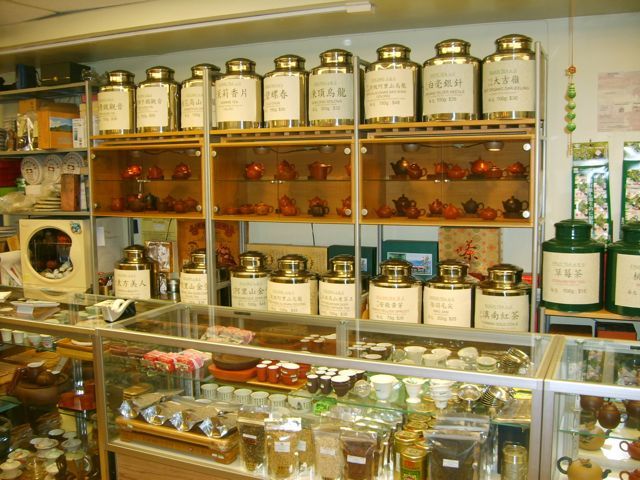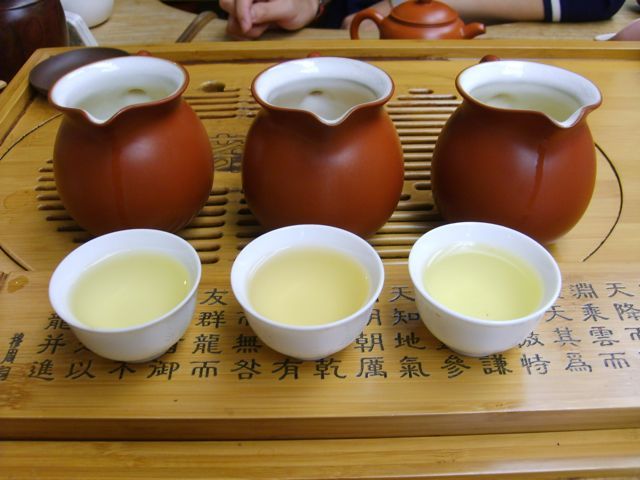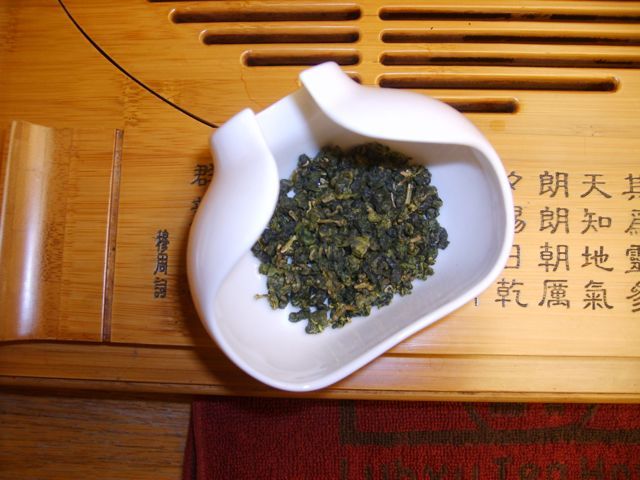9.20.10 Guest Glutton: Tea Time
I'm so excited to have my first guest on GFL! Especially since it's the über-erudite aesthete and man about town Christopher Voigt, whose own blog, vetivresse, taught me (more than) a thing or two about wine and fragrance, and their convergence on the palate. He's been on hiatus from posting (though rumored to be returning soon), but not from gadding about eating and drinking to his heart's content. While this might mean burgers and beer to some (or broccoli and bourbon, as the case may be), Christopher tends to take the high road. So without further ado, I present the first in a series he's writing for us on tea.

Luh Yuh shop in QueensIt’s no secret I’m a tea lover. Attributable, to an English grandmother, perhaps. But I’ve come a long way from White Rose and Typhoo drunk with creamers-full of whole milk and that requisite spoonful of sugar. If you look through my kitchen cabinet you will find canisters of black tea from Sri Lanka and India, Kenya and mainland China. But besides vintage Pu-erh, which I will address in a future post, the teas I most prize are the semi-fermented oolong teas––sometimes called “blue” teas––from the mountains of Taiwan. Early each summer I treat myself to a few vacuum-sealed bags of “Spring Tea” from Li-Shan (Pear Mountain) in central Taiwan. It is this sub-tropical, high-altitude region that produces one of the most exquisitely perfumed oolongs available. The popularity and rarity of the spring harvest tea from Li-Shan guarantee that it flies off importers’ shelves here in the States.Annie and Ren Ro, who run Luh Yu Tea Emporium in Flushing, recently hosted me for a leisurely afternoon tasting of some of their recent selections. Their shop, which opened in 2005, is a peaceful downstairs oasis amid the rapidly growing sprawl of Queens’ mecca of all things Oriental. (And yes, that word is permissible here.)One of the first things you notice about most of the mountain oolongs is the rolled-leaf nature of the tea. About a hundred years ago the tea masters of Fujian Province brought this Ti Kuan Yin style of rolling the tea leaf which increases the enzymatic action in the tea, contributing to deeper flavor and a more beguiling perfume.
All of this was borne out by the traditional Gong Fu method of steeping the tea. The three of us sat at a tea table with a slatted wood top that allowed Annie to pour hot water over the clay pot and leaves, and to present us with the various stages of the preparation process. First, we inspected and smelled the tea fresh; then we smelled it after the teapot was rinsed; and again, after the leaves were wetted. Once the tea had been steeped, it was poured into an “aroma cup” (a sort of midget-vase used to evaluate the aroma) and then poured into a tiny clay cup glazed in white to show the tea’s true hue. One of the great qualities of a high-quality rolled-leaf tea is its longevity. Each tea that we tasted was submitted to 4–5 steepings, and each one revealed another facet of the tea.
A relatively rare “Summer Oolong,” from the ubiquitous Green Heart variety of Li-Shan, exhibited a similar white-floral and rhubarb aroma to the Spring Tea I’d enjoyed in early June, but the summer oolong yielded a more tannic (bitter) experience on the palate. Next up was a “Golden Lily,” or Chin Tsuan oolong from spring 2005 (which the proprietors had re-roasted). Yellow-gold with glints of apricot, the taste was more savory and less “fresh” than the others. Third was a “Four Seasons Spring” from lower-altitude Nantou County. It was lighter green in appearance and, just wet, had an aroma of freshly cut grass. The fourth steep revealed a tea so floral and perfumed that I joked it could be made into “Lu Yu No. 5” and dabbed at the wrists and neck.Annie and Ren agreed that the more acidic a tea, the more it lends itself to sweet foods. (As with wine-and-food pairings, a healthy bit of tension always interests nose and palate more than mere flab or zip.) But, as a rule, the ceremony of tea is best performed sans dessert and, as I learned that day, over a leisurely break of a few hours. Come to think of it, we spent three hours drinking just three teas!









3 Comments